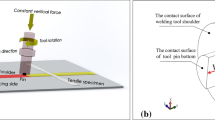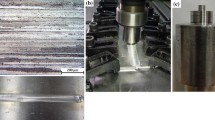Abstract
Friction stir welding (FSW) is an important welding technique where in, and optimizing the process parameters will improve the joint strength of the welds. The FSW process and tool parameters play a major role in determining the joint strength. In this paper, an attempt has been made to establish an empirical relationship between the FSW process parameters (rotational speed, welding speed, and axial force) and predicting the maximum tensile strength of the joint. Statistical tools such as design of experiments, analysis of variance, and regression analysis are used to develop the relationships. A non-heat treatable aluminum alloy Aluminium Association 5059 of 4 mm thickness was used as the base material. Response surface methodology is employed to develop the mathematical model. Analysis of variance technique is used to check the adequacy of the developed mathematical model. The developed mathematical model can be used effectively at 95 % confidence level. The effect of FSW process parameter on mechanical property of Aluminium Association 5059 aluminum alloy has also been analyzed in detail.
Similar content being viewed by others
References
Thomas W M, Nicholas E D, Needham J C, Dawes CJ (1991) Friction stir butt welding. International Patent Application No.PCT/GB9/02203.
Mishra RS (2005) Friction stir welding and processing. Mater Sci Eng 50:1–78
Nandan T, Bhadeshia KDH (2008) Recent advances in friction stir welding–process, weldment structure and properties. Prog Mater Sci 53:980–1023
Lakshminarayanan AK, Balasubramanian V (2008) Process parameters optimization for friction stir welding of RDE-40 aluminium alloy using Taguchi technique. Nonferrous Met Soc China 18:548–554
Blignault C, Hattingh DG, James MN (2012) Optimizing friction stir welding via statistical design of tool geometry and process parameters. J Mater Eng Perform 21(6):927–935
Karthikeyan R, Bala Subramanian V (2010) Prediction of the optimized friction stir spot welding process parameters for joining AA 2024 aluminum alloy using RSM. Int J Adv Manuf Technol 51(1–4):173–183
Zhang Z, Zhang HW (2007) Material behaviours and mechanical features in friction stir welding process. Int J Adv Manuf Technol 35:86–100
Bitondo C, Prisco U, Squillice A, Buonadonna P, Dionora G (2011) Friction stir welding of AA 2198 butt joints: mechanical characterization of the process and of the welds through DOE analysis. Int J Adv Manuf Technol 53:505–516
Raja kumar S, Muralidharan C, Balasubramanian V (2010) Establishing empricial relationships to predict grain size and tensile strength of friction stir welded AA 6061-T6 aluminium alloy joints. 1863–1872
Hamilton C, Dymek S, Blicharski M (2007) Mechanical properties of al 6061 welds by friction stir welding and metal inert gas welding. Arch Metall Mater 52:67–72
Elangovan K, Balasubramanian V, Babu S (2009) Predicting tensile strength of friction stir welded 6061 aluminium alloy joints by mathematical model. Mater Des 30:188–193
Liu Y, Wang W, Xie J, Sun S, Wang L, Qian Y, Meng Y, Wei Y (2012) Micro structure and mechanical properties of aluminium 5083 weldments by gas tungsten arc and gas metal arc welding. Mater Sci Eng A 549:7–13
Anderson T (2003) New developments within the Aluminium Shipbuilding Industry. 58:3–5
Elangovan K, Bala Subramanian V, Babu S, Balaswubramanian M (2008) Optimising friction stir welding parameters to maximize tensile strength of AA 6061 aluminium alloy joints. Int J Manuf Res 3:3
American society for testing and materials (ASTM). In Standard test methods for tension testing of metallic materials, vol. 03.01. West Conshohocken (PA): Annual book of ASTM standards.
Montogomery DC (1984) Design and analysis of experiments. Wiley, New York
Balasubramanian M, Jayabalan V, Balasubramanian V (2008) Developing mathematical models to predict tensile properties of pulsed current gas tungsten arc welded Ti-6Al-4V alloy. Mater Des 29:92–97
Rajakumar S, Muralidharan C, Balasubramanian V (2010) Optimization of the friction stir welding process and the tool parameters to attain a maximum tensile strength of AA7075-T6 aluminium alloy. J Eng Manuf 224:1175–1191
Hartawan A, Thoe T B, Ng, S T, Wu H, Liu K (2009) Initial Investigation of Friction Stir Welding. SIMTech Technical Reports: 10(1)
Author information
Authors and Affiliations
Corresponding author
Rights and permissions
About this article
Cite this article
Babu, N., Karunakaran, N. & Balasubramanian, V. A study to estimate the tensile strength of friction stir welded AA 5059 aluminium alloy joints. Int J Adv Manuf Technol 93, 1–9 (2017). https://doi.org/10.1007/s00170-015-7391-9
Received:
Accepted:
Published:
Issue Date:
DOI: https://doi.org/10.1007/s00170-015-7391-9




